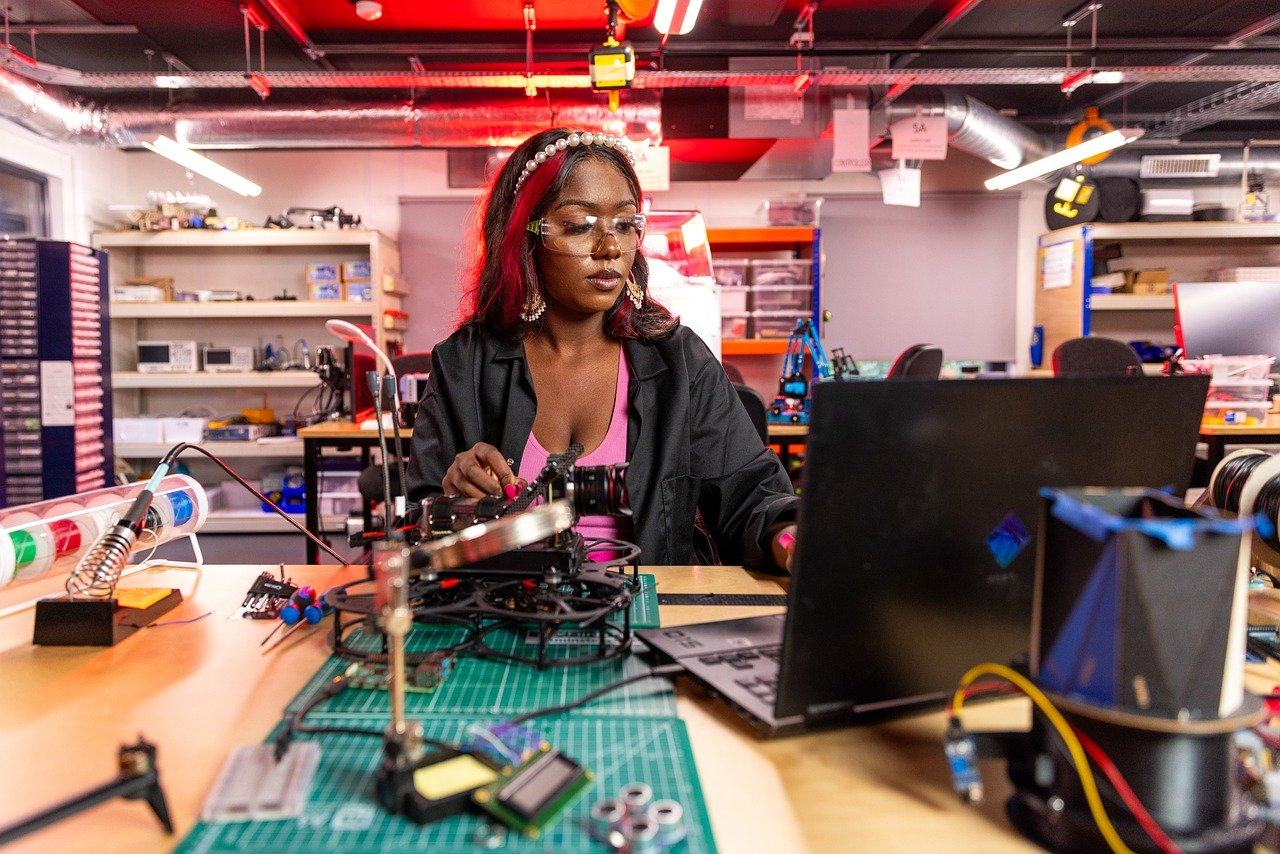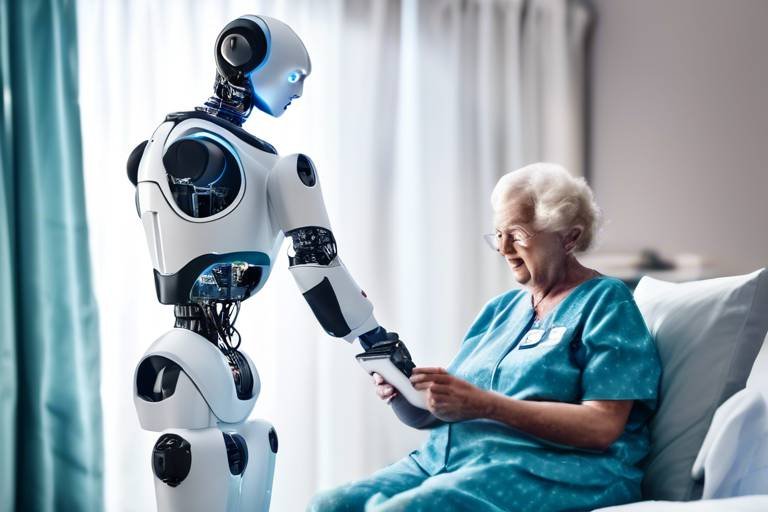How Robotics Will Transform Home Care Services
The world of home care services is on the brink of a revolution, thanks to the rapid advancements in robotics technology. Imagine a future where your loved ones can receive care in the comfort of their homes, aided by intelligent machines that not only assist with daily tasks but also enhance the overall quality of life. This isn't just a dream; it’s becoming a reality as robotics increasingly integrates into home care. But how exactly will these innovations change the landscape of caregiving? Let's dive into the transformative impact that robotics is poised to have on home care services.
As we navigate through this exciting era, it's essential to understand that the integration of robotics into home care is not merely about replacing human touch; rather, it's about augmenting the existing care systems. With the help of robots, caregivers can focus on what truly matters—providing emotional support and companionship—while technology handles the more mundane tasks. The synergy between human caregivers and robotic assistants promises to create a more efficient and effective care environment.
Moreover, the rise of robotics in home care isn't just about technology; it's about addressing the growing needs of an aging population. As more individuals prefer to age in place, the demand for innovative solutions to support their independence becomes increasingly critical. Enter robotics: equipped with the capability to assist with everything from medication management to mobility, these machines are set to become indispensable allies in the home care sector.
In the following sections, we will explore the various types of home care robots and their unique functions, the numerous benefits they bring, the challenges they face, and the future trends that will shape the caregiving landscape. Each aspect will illustrate how robotics is not just changing home care but is redefining what it means to provide care in today’s world.
- What types of robots are used in home care? There are various types of robots, including companion robots, mobility aids, and telepresence devices, each serving distinct roles to assist patients and caregivers.
- Are home care robots safe? Yes, home care robots are designed with safety in mind, but it's essential to ensure they are compliant with regulatory standards.
- How can caregivers be trained to use these technologies? Training programs are crucial to equip caregivers with the skills needed to effectively utilize robotic technologies.

The Rise of Robotics in Home Care
As we step into a new era of technological advancements, the integration of robotics into home care services is not just a trend—it's a revolution. Imagine a world where elderly individuals can maintain their independence, receive assistance when needed, and enjoy companionship without the constant presence of a caregiver. This is becoming a reality as robotics technology evolves and is increasingly adopted in home care settings. The rise of robotics in home care is driven by several factors, including the aging population, the demand for quality care, and the need for efficiency in caregiving.
The aging population is one of the primary catalysts for this transformation. With a growing number of seniors preferring to age in place, there is a pressing need for solutions that can support their daily living activities. Robotics provides a viable answer, offering tools that can assist with everything from medication management to mobility support. Moreover, the COVID-19 pandemic has accelerated the adoption of technology in healthcare, highlighting the importance of minimizing human contact while ensuring that patients receive the care they need.
Robots, equipped with advanced sensors and artificial intelligence, can perform a variety of tasks that enhance the quality of care. For instance, companion robots can engage in conversations, provide reminders for medications, and even monitor a patient's emotional well-being. These robots serve as both assistants and companions, reducing feelings of loneliness and isolation among seniors. Furthermore, mobility aids like robotic exoskeletons help individuals regain their independence by enabling them to move around safely and confidently.
In terms of efficiency, robotics can help streamline caregiving processes, allowing human caregivers to focus on more complex tasks that require empathy and critical thinking. With the help of telepresence robots, caregivers can check in on patients remotely, ensuring continuous monitoring and support without the need for physical presence. This not only enhances patient care but also alleviates the burden on caregivers who often face overwhelming workloads.
However, the rise of robotics in home care is not without its challenges. Concerns regarding the acceptance of robotic solutions by both patients and caregivers persist. Many individuals may feel hesitant to embrace technology, fearing that it may replace human interaction or diminish the quality of care. To overcome these barriers, it is essential to foster an understanding of the role that robots can play as supportive tools rather than replacements for human caregivers.
In conclusion, the rise of robotics in home care services signifies a profound shift in how we approach caregiving. By leveraging technology, we can create a future where individuals receive the support they need while maintaining their independence and dignity. As we continue to innovate and integrate these technologies, it is crucial to address the challenges and ensure that both patients and caregivers feel empowered and supported in this new landscape.
- What types of robots are used in home care? There are various types of robots, including companion robots, mobility aids, and telepresence devices, each serving unique functions to assist patients and caregivers.
- How do robots improve patient care? Robots enhance patient care by providing companionship, assisting with daily tasks, and allowing caregivers to monitor patients remotely.
- What are the challenges of implementing robotics in home care? Some challenges include high costs, technological limitations, and resistance from caregivers and patients.

Types of Home Care Robots
In the ever-evolving landscape of home care, robotics has emerged as a game changer, offering innovative solutions that cater to a variety of needs. The integration of robotic technology into home care services has led to the creation of several types of robots, each designed to fulfill specific roles and enhance the caregiving experience. These robots can be broadly categorized into three main types: companion robots, mobility aids, and telepresence devices.
Companion robots, as the name suggests, are primarily designed to provide emotional support and companionship to patients. These robots can engage in conversations, play games, and even remind users to take their medications. Imagine a friendly robot that not only keeps an elderly person company but also monitors their mood and alerts caregivers if something seems off. This is not science fiction; it’s happening right now!
Mobility aids represent another vital category of home care robots. These devices assist individuals with limited mobility in performing daily tasks. For instance, robotic walkers and exoskeletons can help patients regain their independence by providing support and stability as they move around their homes. The technology behind these mobility aids is improving rapidly, making them more accessible and user-friendly. The impact is profound, as they can significantly reduce the risk of falls and injuries, allowing patients to maintain a higher quality of life.
Telepresence devices take the concept of remote care to the next level. These robots allow healthcare professionals to connect with patients from a distance, offering virtual consultations and monitoring. Picture a doctor being able to check in on a patient without leaving their office, thanks to a telepresence robot that can navigate through the home and provide real-time data. This not only saves time but also ensures that patients receive timely care without the stress of travel.
To illustrate the different types of home care robots, the following table summarizes their key features and functions:
| Type of Robot | Key Features | Functions |
|---|---|---|
| Companion Robots | Conversational abilities, emotional support | Engagement, medication reminders |
| Mobility Aids | Supportive frameworks, stability features | Enhanced movement, fall prevention |
| Telepresence Devices | Remote connectivity, real-time monitoring | Virtual consultations, health tracking |
As we delve deeper into the world of home care robotics, it’s crucial to understand that these innovations are not just about technology; they are about enhancing the quality of life for patients and providing much-needed support to caregivers. Each type of robot plays a unique role in this ecosystem, creating a synergy that brings together the best of both worlds—human compassion and robotic efficiency. The future of home care is not just about robots taking over; it’s about them augmenting human capabilities, making caregiving more effective and less burdensome.
In summary, the types of home care robots available today showcase a fascinating blend of technology and empathy, each designed to address specific challenges faced by patients and caregivers alike. As we continue to explore the possibilities of robotics in home care, we can only imagine the exciting developments that lie ahead.
- What are companion robots? Companion robots are designed to provide emotional support and companionship to individuals, often engaging in conversation and reminding users about important tasks.
- How do mobility aids work? Mobility aids assist individuals with limited mobility by providing support and stability, helping them perform daily activities safely.
- What is a telepresence device? Telepresence devices allow healthcare professionals to connect with patients remotely, facilitating virtual consultations and real-time monitoring of health conditions.

Benefits of Robotics in Home Care
When we think about home care, the first images that may come to mind are nurses, caregivers, and family members providing support to those in need. However, the introduction of robotics into this field is dramatically reshaping the landscape. Imagine a world where technology not only assists but enhances the quality of care provided to patients. That's the promise of robotics in home care, and the benefits are as impressive as they are numerous.
One of the most significant advantages of incorporating robotics into home care is the increased safety it offers. For instance, robots designed for monitoring can alert caregivers to any changes in a patient's condition, potentially preventing emergencies before they escalate. This is particularly crucial for elderly patients who may be at risk of falls or sudden health changes. With the assistance of robotics, caregivers can focus on providing personal care while technology handles monitoring tasks.
Furthermore, robotics enhances patient monitoring through advanced sensors and real-time data collection. These robots can track vital signs, medication adherence, and even daily activities, giving caregivers a comprehensive view of a patient's health status. This data can be analyzed to detect patterns that might indicate health issues, allowing for timely interventions. It's like having a personal health assistant that never sleeps!
Another notable benefit is the reduction of caregiver workload. Caregiving can be physically and emotionally demanding, often leading to burnout among those who provide it. Robots can take on repetitive tasks such as medication reminders, mobility assistance, and even companionship. This not only alleviates some of the burdens on human caregivers but also allows them to devote more time to the emotional and social aspects of care that technology simply cannot replace.
Moreover, the use of robotics can significantly improve patient engagement. Companion robots, for example, are designed to interact with patients, offering conversation and entertainment. This can help combat feelings of loneliness and isolation, particularly among elderly individuals. When patients feel more connected, their overall well-being improves, leading to better health outcomes.
To illustrate the benefits more clearly, consider the following table that summarizes key advantages of robotics in home care:
| Benefit | Description |
|---|---|
| Increased Safety | Robots monitor patients and alert caregivers to emergencies. |
| Enhanced Patient Monitoring | Real-time tracking of vital signs and health metrics. |
| Reduced Caregiver Workload | Robots handle repetitive tasks, allowing caregivers to focus on personal care. |
| Improved Patient Engagement | Companion robots provide social interaction and reduce feelings of isolation. |
In conclusion, the integration of robotics into home care services is not just a trend; it's a transformative shift that brings undeniable benefits. From enhancing safety and monitoring to reducing caregiver burdens and improving patient engagement, robotics is paving the way for a new era in caregiving. As we move forward, embracing these advancements will be crucial in ensuring that we provide the best possible care for those who need it most.
- What types of robots are used in home care? Various types, including companion robots, mobility aids, and telepresence devices, are designed to assist patients and caregivers.
- Are home care robots safe? Yes, many home care robots are designed with safety features and undergo rigorous testing to ensure they meet health standards.
- How do robots improve caregiver efficiency? Robots can take over repetitive tasks, allowing caregivers to focus on providing personalized care.
- Will robots replace human caregivers? No, robots are designed to assist human caregivers, not replace them. The human touch in caregiving remains irreplaceable.

Challenges and Limitations of Robotics
While the integration of robotics into home care services promises a brighter future, it is not without its challenges and limitations. One of the most significant hurdles is the high cost associated with developing and implementing robotic technologies. For many home care providers, especially smaller organizations, the initial investment can be daunting. This financial barrier often leads to the question: can we really afford to embrace these advancements when budgets are already stretched thin?
Moreover, there are technological limitations that cannot be overlooked. Current robots may not yet possess the level of sophistication required to handle complex caregiving tasks autonomously. For instance, while a robot may assist with medication reminders or basic mobility support, it may struggle with understanding nuanced human emotions or making critical decisions in emergencies. This limitation raises concerns about the extent to which robots can truly replace the human touch in caregiving, which is often essential for building trust and rapport with patients.
Another significant challenge is the resistance from caregivers and patients. Many caregivers fear that robots could replace their jobs, leading to job insecurity and emotional distress. Patients, especially the elderly, may feel uncomfortable or anxious about interacting with machines rather than human caregivers. This psychological barrier can impede the acceptance and effective use of robotic technologies in home care settings. It's crucial to address these concerns through education and open dialogue, emphasizing that robots are designed to assist, not replace, human caregivers.
Additionally, there are regulatory considerations that complicate the landscape. The development and deployment of robotic technologies in healthcare must comply with various safety standards and regulations. These requirements can slow down the innovation process, as companies must ensure that their products meet rigorous guidelines before they can be used in real-world settings. This regulatory landscape can be a double-edged sword—while it ensures safety, it can also stifle creativity and limit the speed at which new technologies are introduced.
In summary, while the potential of robotics in home care is immense, several challenges must be addressed to fully realize its benefits. From high costs and technological limitations to resistance from caregivers and regulatory hurdles, the journey towards a robotic-enhanced caregiving future is fraught with obstacles. However, with ongoing innovation and collaboration among stakeholders, these challenges can be navigated, paving the way for a more efficient and compassionate home care system.
- What are the main challenges of using robots in home care? The main challenges include high costs, technological limitations, resistance from caregivers and patients, and regulatory hurdles.
- Can robots replace human caregivers? While robots can assist with certain tasks, they cannot fully replace the emotional support and human touch that caregivers provide.
- How can we address the resistance to robots in home care? Education and open dialogue about the role of robots as assistants rather than replacements can help alleviate concerns.
- What are the regulatory considerations for home care robotics? Companies must comply with safety standards and regulations, which can slow down the introduction of new technologies.

Case Studies: Successful Implementations
The integration of robotics into home care services has shown remarkable potential, with several case studies illustrating the transformative effects of these technologies. One notable example is the use of companion robots in the homes of elderly patients. These robots, designed to engage and interact with users, have been implemented in various communities across the United States. In a pilot program in California, researchers found that patients who interacted with companion robots reported a 30% increase in overall well-being compared to those who did not use such technology. The robots provided not only companionship but also reminders for medication and appointments, significantly enhancing the quality of life for these individuals.
Another compelling case study comes from a healthcare facility in Japan, where a robotic mobility aid named Robi was introduced. This device assists patients with limited mobility, enabling them to perform daily tasks that would otherwise require human assistance. In this facility, staff noted a 40% reduction in caregiver workload as patients became more independent. The success of Robi has led to its adoption in numerous home care settings, showcasing how technology can empower patients while alleviating pressure on caregivers.
Furthermore, telepresence robots have emerged as a game-changer in home care. For instance, a family in New York utilized a telepresence robot to connect their elderly mother with her healthcare providers remotely. This innovation allowed for real-time consultations and monitoring, which not only improved the patient’s health outcomes but also provided peace of mind for her family. The flexibility and accessibility of telepresence technology have made it an invaluable resource, especially during times when in-person visits are challenging.
To illustrate the impact of these technologies, consider the following table summarizing key findings from various implementations:
| Case Study | Technology Used | Key Benefits |
|---|---|---|
| California Companion Robot Program | Companion Robots | 30% increase in well-being, medication reminders |
| Japan Mobility Aid Facility | Robotic Mobility Aid (Robi) | 40% reduction in caregiver workload, enhanced independence |
| New York Telepresence Robot | Telepresence Robots | Improved health outcomes, remote consultations |
These case studies not only highlight the practical benefits of robotics in home care but also demonstrate the profound impact such technologies can have on the lives of patients and their families. As we move forward, the success of these implementations serves as a beacon of hope, showing that with the right tools, we can significantly improve the caregiving experience.
Q: What are companion robots, and how do they help?
A: Companion robots are designed to engage with patients, offering companionship, reminders for medication, and even entertainment. They help reduce feelings of loneliness and improve overall well-being.
Q: How do robotic mobility aids work?
A: Robotic mobility aids assist individuals with limited mobility by providing support for daily tasks and activities, allowing them to maintain independence and reduce the workload on caregivers.
Q: What are telepresence robots?
A: Telepresence robots allow patients to connect with healthcare providers remotely. They enable real-time consultations and monitoring, enhancing access to care and improving health outcomes.

Future Trends in Home Care Robotics
The future of home care robotics is not just a fleeting dream; it’s unfolding right before our eyes, and the possibilities are as exciting as they are transformative. As technology continues to advance at breakneck speed, we can expect a plethora of innovations that will redefine how care is delivered in the comfort of homes. Imagine a world where robots not only assist with daily activities but also learn and adapt to the unique needs of each individual. This is not science fiction; it’s the emerging reality of home care robotics.
One of the most promising trends is the integration of artificial intelligence (AI) and machine learning into robotic systems. These technologies enable robots to analyze vast amounts of data, recognize patterns, and make informed decisions. For instance, a robot equipped with AI could monitor a patient’s vital signs and detect anomalies, alerting caregivers before a situation escalates. This proactive approach not only enhances patient safety but also empowers caregivers to focus on more complex tasks that require human empathy and judgment.
Moreover, the role of virtual assistants in home care is on the rise. These digital companions can provide reminders for medication, assist with scheduling appointments, and even engage in conversation to combat loneliness. Think of them as a friendly voice in the home, always ready to lend a helping hand. As these virtual assistants become more sophisticated, they will seamlessly integrate with physical robots, creating a holistic care environment that caters to both physical and emotional needs.
Another trend to watch is the development of collaborative robots or cobots, designed to work alongside human caregivers. Unlike traditional robots that operate independently, cobots are built to enhance human capabilities. They can assist with lifting patients, managing heavy equipment, or performing routine tasks, thereby reducing the physical strain on caregivers. This collaboration not only improves efficiency but also fosters a more harmonious working relationship between humans and machines.
However, with all these advancements, there are challenges to consider. The ethical implications of using robotics in home care must be addressed. Questions surrounding privacy, data security, and the emotional impact of robotic companions on patients and families are paramount. As we embrace these technologies, it’s crucial to establish guidelines that ensure they enhance rather than hinder the caregiving experience.
Lastly, the accessibility of robotics will play a significant role in shaping the future of home care. As costs decrease and technology becomes more user-friendly, we can expect wider adoption across various demographics. This democratization of care technology means that not only affluent families will benefit from robotic assistance, but also those in underserved communities. The goal is to create a future where high-quality care is available to everyone, regardless of their socioeconomic status.
In conclusion, the future of home care robotics is bright and filled with potential. As we continue to innovate and adapt, the integration of AI, virtual assistants, and collaborative robots will revolutionize how care is delivered. By addressing ethical concerns and ensuring accessibility, we can create a supportive environment that enhances the quality of life for both patients and caregivers alike.
- What are the main benefits of using robotics in home care? Robotics can enhance patient safety, improve monitoring, and reduce the workload on caregivers.
- How does AI improve home care robotics? AI allows robots to analyze data, recognize patterns, and make informed decisions to assist in patient care.
- What ethical concerns are associated with home care robotics? Privacy, data security, and the emotional impact of robotic companions are significant ethical considerations.
- Will robotics in home care be accessible to everyone? As technology advances and costs decrease, it’s expected that more families will have access to robotic assistance.

Regulatory Considerations
As the integration of robotics into home care services accelerates, the regulatory landscape surrounding these technologies becomes increasingly important. Ensuring that robots used in caregiving meet certain safety and efficacy standards is crucial for protecting both patients and caregivers. Regulatory bodies, such as the Food and Drug Administration (FDA) in the United States, have begun to outline guidelines that govern the use of robotic technologies in healthcare settings. These regulations are designed to ensure that robots are not only effective but also safe for everyday use.
One of the primary challenges in regulating home care robotics is the rapid pace of technological advancement. As new features and capabilities are developed, regulators must keep up to ensure that existing guidelines remain relevant. This often means that the regulatory framework must be flexible enough to adapt to new innovations while still providing the necessary safeguards. For instance, the introduction of artificial intelligence in robotic systems raises questions about accountability and decision-making processes. Who is responsible if a robot makes an error? This is a critical issue that regulators are currently grappling with.
Furthermore, compliance with healthcare standards is essential for the successful deployment of robotic systems in home care. Manufacturers must demonstrate that their products meet rigorous testing and evaluation criteria before they can be approved for use. This includes proving that the robots can effectively assist with tasks such as medication management, mobility support, and patient monitoring. The table below summarizes key regulatory considerations for robotics in home care:
| Regulatory Aspect | Description |
|---|---|
| Safety Standards | Ensuring that robots operate safely without posing risks to patients or caregivers. |
| Effectiveness | Demonstrating that robotic systems can perform intended tasks reliably and efficiently. |
| Data Privacy | Compliance with regulations regarding the handling of personal health information. |
| Training Requirements | Establishing guidelines for training caregivers to use robotic technologies effectively. |
In addition to safety and effectiveness, data privacy is another critical regulatory consideration. Home care robots often collect sensitive patient information, and ensuring that this data is protected from breaches is vital. Compliance with laws such as the Health Insurance Portability and Accountability Act (HIPAA) in the U.S. is necessary to maintain patient confidentiality and trust.
As the landscape of home care continues to evolve, it's essential for stakeholders—including manufacturers, healthcare providers, and regulators—to collaborate closely. By working together, they can create a comprehensive regulatory framework that not only fosters innovation but also prioritizes patient safety and quality of care. In doing so, we can ensure that the benefits of robotics in home care are realized while minimizing potential risks.
- What are the main regulatory bodies overseeing home care robotics? The FDA in the U.S. is a primary regulatory body, alongside other organizations that focus on healthcare standards and safety.
- How do regulations affect the development of new robotic technologies? Regulations ensure that new technologies meet safety and efficacy standards, which can influence design and functionality.
- What happens if a home care robot malfunctions? Manufacturers are responsible for ensuring that their robots are safe and effective; however, accountability can vary based on the circumstances.
- Are there specific training requirements for caregivers using robotic systems? Yes, caregivers must be trained to use robotic technologies effectively to maximize their benefits and ensure patient safety.

Training and Support for Caregivers
As we embrace the integration of robotics into home care services, the importance of training and support for caregivers cannot be overstated. Think about it: how can caregivers effectively utilize cutting-edge technology without proper guidance? Just like a pilot needs to master flying before taking to the skies, caregivers must be equipped with the knowledge and skills to operate robotic systems efficiently. This training ensures that they can leverage the full potential of these innovations, enhancing both patient care and their own work experience.
Training programs should be designed to cover various aspects of robotic technology, including operation, maintenance, and troubleshooting. For instance, caregivers should understand how to interact with companion robots, which can provide emotional support and companionship to patients. This interaction is crucial, as it not only improves the patient's quality of life but also alleviates feelings of loneliness and isolation. Additionally, caregivers need to learn how to use mobility aids that assist patients in moving safely around their homes, ensuring they maintain their independence while minimizing the risk of falls.
Furthermore, the training should include a strong emphasis on communication skills. Caregivers will need to explain the functionalities of these robotic devices to patients and their families, helping them feel more comfortable and confident in using the technology. This is where support becomes vital; ongoing assistance and resources can help caregivers navigate any challenges they face while integrating robotics into their daily routines. Support can come in various forms, such as online tutorials, webinars, or on-site training sessions, which can be tailored to the specific needs of the caregivers and the technologies they are using.
Additionally, it’s essential to foster a culture of collaboration between caregivers and technology developers. By involving caregivers in the design and testing phases of new robotic systems, developers can gain valuable insights into the real-world challenges caregivers face. This collaborative approach not only leads to better-designed products but also empowers caregivers, making them feel valued and heard in the process.
To truly maximize the benefits of robotics in home care, organizations must also prioritize continuous education. As technology evolves, so too should the training programs. Regular updates and refresher courses will ensure that caregivers remain adept at using new features and functionalities, ultimately leading to improved patient outcomes. Moreover, providing a platform for caregivers to share their experiences and best practices can foster a community of learning and support.
In conclusion, investing in comprehensive training and support systems for caregivers is not merely an option; it is a necessity. By equipping caregivers with the right tools and knowledge, we can enhance the quality of care provided to patients, making the transition to a more robotic-assisted home care environment smooth and effective. After all, the ultimate goal is to create a harmonious blend of human compassion and robotic efficiency that transforms the caregiving landscape.
- What types of training are available for caregivers using robotics?
Training can include hands-on workshops, online courses, and ongoing support through webinars and tutorials. - How can caregivers stay updated on new robotic technologies?
Caregivers should participate in continuous education programs and subscribe to industry newsletters to keep abreast of advancements. - Is there a cost associated with caregiver training for robotics?
Costs can vary based on the provider and the type of training offered, but many organizations offer subsidized programs. - How can caregivers provide feedback on robotic systems?
Caregivers can communicate their experiences and suggestions directly to technology developers or through organizational feedback channels.
Frequently Asked Questions
- How do robotics improve home care services?
Robotics enhance home care services by increasing efficiency and improving the quality of patient care. They can assist with daily tasks, monitor health conditions, and provide companionship, allowing caregivers to focus on more complex needs.
- What types of robots are used in home care?
There are several types of robots designed for home care, including:
- Companion robots that provide social interaction and emotional support.
- Mobility aids that help patients move safely within their homes.
- Telepresence devices that allow healthcare professionals to connect with patients remotely.
- What are the main benefits of using robotics in home care?
The benefits of robotics in home care include:
- Increased safety for patients and caregivers.
- Enhanced monitoring of patient health and well-being.
- Reduced workload for caregivers, allowing them to provide better care.
- What challenges do robotics face in home care?
Implementing robotics in home care comes with challenges such as high costs, technological limitations, and sometimes resistance from both caregivers and patients who may feel uncomfortable with new technologies.
- Are there any successful case studies of robotics in home care?
Yes, there are several real-world examples where robotics have been successfully integrated into home care settings, leading to improved patient outcomes and enhanced experiences for caregivers. These case studies highlight the positive impact of innovative technologies in caregiving.
- What future trends can we expect in home care robotics?
Emerging trends in home care robotics include advancements in artificial intelligence, machine learning, and the increasing use of virtual assistants. These technologies are expected to further enhance the capabilities of home care robots, making them even more effective in supporting both patients and caregivers.
- What are the regulatory considerations for using robotics in home care?
The regulatory landscape for robotics in home care includes safety standards and compliance requirements set by health organizations. These regulations ensure that robotic technologies are safe and effective for patient use.
- How important is training for caregivers using robotics?
Training is crucial for caregivers to effectively utilize robotic technologies. Proper training ensures that caregivers can maximize the benefits of these innovations, leading to better care for patients and a smoother integration of technology into their daily routines.



















